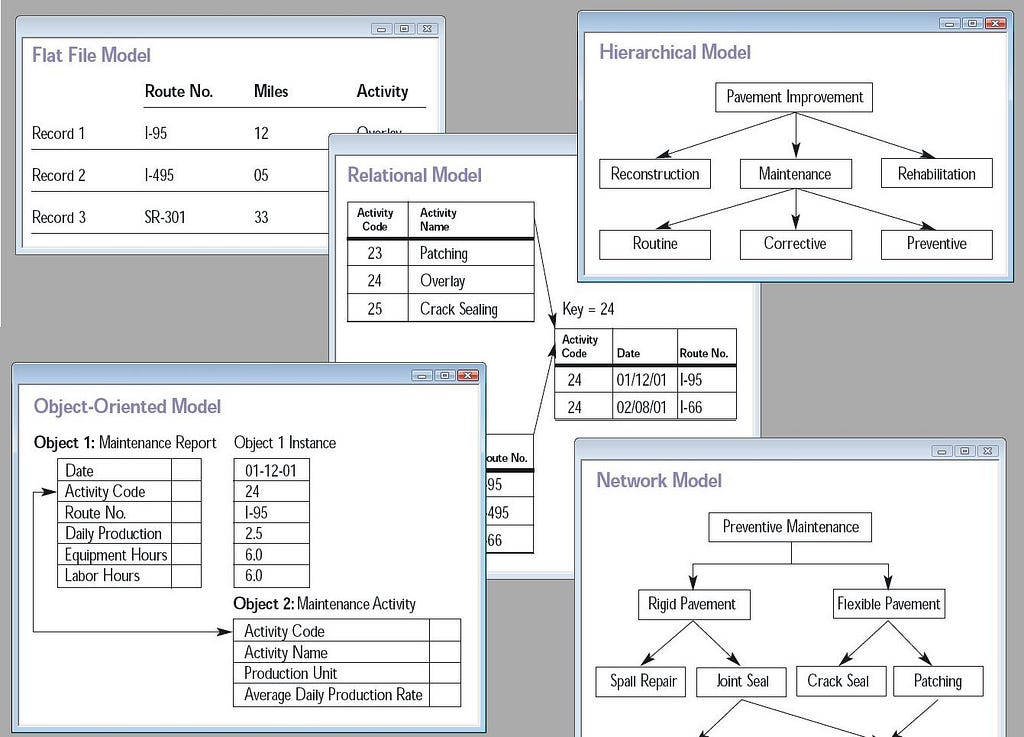Table Of Content

Learn to create efficient and scalable databases for any application. New to this edition are more examples, highlighted and defined key terms, both throughout and at the end of each chapter, and end-of-chapter review exercises. Two new chapters have been added on SQL, along with appendices that include a data model example, sample ERD exercises and SQL lab with solutions. Examples are typical business examples which are relevant and current. Example database designs are very simple to comprehend so that emphasis is placed on learning the concepts. Suggestion - the text focus is on designing for operational data.
What is an entity relationship diagram (ERD)? Definition from TechTarget - TechTarget
What is an entity relationship diagram (ERD)? Definition from TechTarget.
Posted: Mon, 28 Feb 2022 22:03:07 GMT [source]
Exploring the Different Types of Data Models
These are the kinds of insights that are gained from creating an ERD as part of the database construction process, saving us time later in the process by surfacing possible problems early. This is part 1 of a 3-part series taking you through the process of designing, coding, implementing and querying a relational database, starting from zero. See part 2 (Coding and Implementing a Relational Database using MySQL) here, and part 3 (Data Analysis in MySQL — Operators, Joins and More in Relational Databases) here. A poorly designed database makes it difficult to access the information you need and can jeopardize the accuracy of your data.
New to Software Development? Start here.

Versioning can be implemented using various technologies and tools, such as version control systems, backup systems, or database features. Caching is a technique of storing frequently used or recently accessed data in memory or disk, to reduce latency and workload. Caching can improve the performance and scalability of applications that need to access data from remote or slow sources, such as databases or web services. Caching can also reduce the cost of data access by minimizing network traffic and resource consumption. Caching can be implemented at different levels, such as application level, database level, or network level. However, there weren’t any theories for how computers could organize data in meaningful, logical ways.
SQLite
MySQL features built-in replication support with ACID compliance, shared-nothing clustering, and supports multiple storage engines. However, using some storage engines can cause SQL not to work properly. When you purchase a Certificate you get access to all course materials, including graded assignments.
Which attributes do we want to store?
SQL allows you to filter and manipulate query results with a variety of clauses, predicates, and expressions, giving you fine control over what data will appear in the result set. Locking prevents other users and applications from accessing data while it is being updated. In some databases, locking applies to the entire table, which creates a negative impact on application performance. Other databases, such as Oracle relational databases, apply locks at the record level, leaving the other records within the table available, helping ensure better application performance.
SQL Queries
When you enroll in the course, you get access to all of the courses in the Certificate, and you earn a certificate when you complete the work. Your electronic Certificate will be added to your Accomplishments page - from there, you can print your Certificate or add it to your LinkedIn profile. If you only want to read and view the course content, you can audit the course for free. Learn key benefits of generative AI and how organizations can incorporate generative AI and machine learning into their business.
Designing a Relational Database and Creating an Entity Relationship Diagram
This is analogous to using the index of a book to go directly to the page on which the information you are looking for is found, so that you do not have to read the entire book to find what you are looking for. Relational databases typically supply multiple indexing techniques, each of which is optimal for some combination of data distribution, relation size, and typical access pattern. The use of efficient indexes on both primary and foreign keys can dramatically improve query performance. This book is quite comprehensive in its coverage of key topic areas expected to be covered in an introductory database course at the undergraduate (bachelor's degree) level.
Step 2: Analyze data requirements
The authors should also consider including an introduction to star schema and snowflake schema topics in order to introduce datamarts and data warehouses in a separate chapter. Last, but not least, the authors should consider using an open-source database such as MySQL for demonstration of SQL concepts rather than MS Access (which is a proprietary and a desktop database software). The software used to store, manage, query, and retrieve data stored in a relational database is called a relational database management system (RDBMS). The RDBMS provides an interface between users and applications and the database, as well as administrative functions for managing data storage, access, and performance. It’s a collection of processes that guide the designing, development, implementation and maintenance of enterprise data management systems.

Future Trends in Database Design and Data Modeling
Creating a single-table design with Amazon DynamoDB Amazon Web Services - AWS Blog
Creating a single-table design with Amazon DynamoDB Amazon Web Services.
Posted: Mon, 26 Jul 2021 07:00:00 GMT [source]
We will want to store the name of the teacher, perhaps their date of birth, their contact information, tax or legal information, and — as this is a language school — the languages they teach. Let’s go through the requirements and see if we can identify our entities. Some people might skip this step and go straight to coding, but creating an ERD to make sure we have everything planned out before we build the database itself is best practice, and strongly recommended.
Clients offer courses to their employees, who have the option to participate. Before you design your database, you’ll need to assess how your team currently does its work, and identify what kind of data is most important to that work. Every organization does its work a little differently, and as such, each organization has its own business rules. Ideally, your team’s database should enforce your unique business rules. This tabular structure shifts the focus to handling data, which allows faster performance and the use of complex, high-level queries. It also causes some limitations, as SQLite only partially provides triggers, has a limited ALTER TABLE function, and cannot write to views.
DrawSQL makes it easy for teams to collaborate on creating and maintaining schema diagrams. With a single source of truth, there's no need for manually syncing diagram files between different developers and offline tools anymore. It will delete the tuples from REFERENCING RELATION if the value used by REFERENCING ATTRIBUTE is deleted from REFERENCED RELATION. E.g.; For, if we delete a row from BRANCH with BRANCH_CODE ‘CS’, the rows in STUDENT relation with BRANCH_CODE CS (ROLL_NO 1 and 2 in this case) will be deleted. Most RDBMS can be setup to perform the check and ensure the referential integrity, in the specified manner.
Now that you have a general understanding of the relational model’s history, let’s take a closer look at how the model organizes data. Finally, after implementing the physical design of the database, we’re ready to input the data & test our integrity. This phase involves testing our database for its integrity to see if something got left out or, if anything new to add & then integrating it with the desired application. However, depending on specific requirements above criteria might change. But these are the most common things that ensure a good database design. In a "product sales" database, a product may have optional supplementary information such as image, moreDescription and comment.
For example, chapter 14 (Database Users) was extremely short, and could have been covered (perhaps was?) in a much earlier chapter like chapter 2 (Fundamental Concepts). However, because it was so short, I worry that there was not enough context provided or depth of explanation so that beginners in this field would be able to follow it with any degree of confidence. I think this book would require HEAVY additional guidance from an instructor.

No comments:
Post a Comment